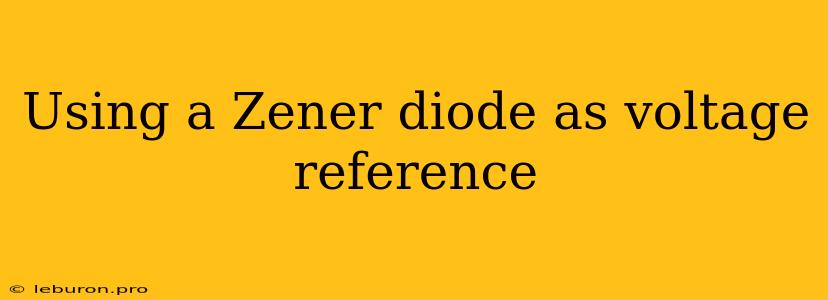In the realm of electronics, precise voltage references are indispensable for a multitude of applications. These references serve as stable and accurate voltage standards, ensuring the proper functioning of circuits and devices. Among the various methods employed to achieve voltage references, utilizing a Zener diode stands out as a simple yet effective technique. This article delves into the principles behind using a Zener diode as a voltage reference, exploring its characteristics, advantages, and practical considerations.
Understanding Zener Diodes
At the heart of this approach lies the Zener diode, a specialized type of semiconductor diode designed to operate in the reverse breakdown region. Unlike conventional diodes that conduct current primarily in the forward direction, Zener diodes exhibit a unique characteristic: they exhibit a sharp voltage drop across their terminals when a reverse bias voltage exceeding a certain threshold, known as the Zener voltage (Vz), is applied. This breakdown phenomenon is highly predictable and stable, making Zener diodes ideal for voltage reference applications.
The Zener Effect
The Zener effect, which governs the operation of Zener diodes, involves the creation of electron-hole pairs within the diode's depletion region under high reverse bias. These carriers, generated by the strong electric field, contribute to a significant increase in reverse current, leading to the characteristic voltage drop. The Zener voltage is determined by the doping concentration of the semiconductor material used in the diode's construction.
Zener Diode as a Voltage Reference
The ability of a Zener diode to maintain a constant voltage across its terminals even with varying current levels makes it a suitable component for voltage reference circuits. When a Zener diode is connected in series with a resistor and a power supply, the diode's breakdown voltage acts as a fixed reference point. The resistor limits the current flowing through the diode, ensuring stable operation within the device's specifications.
Working Principle
The principle behind using a Zener diode as a voltage reference relies on the diode's constant voltage characteristic. When the input voltage exceeds the Zener voltage, the diode enters its breakdown region, and the voltage across it remains practically constant at Vz. Any variations in the input voltage or current are absorbed by the series resistor, maintaining a stable output voltage.
Advantages of Zener Diode Voltage Reference
-
Simplicity: The circuit implementation is straightforward, requiring minimal components.
-
Low Cost: Zener diodes are readily available and relatively inexpensive.
-
Stability: The Zener voltage is highly stable over a wide range of temperatures and currents.
-
Wide Range of Voltages: Zener diodes are available with a wide range of Zener voltages, allowing for flexible design choices.
Practical Considerations
While using a Zener diode as a voltage reference offers several advantages, it's important to consider certain practical aspects.
Temperature Stability
The Zener voltage can vary slightly with temperature. To mitigate this effect, Zener diodes with low temperature coefficients (TC) are preferred. Alternatively, temperature compensation techniques can be employed to improve the stability of the reference voltage.
Power Dissipation
Zener diodes have a maximum power dissipation rating. Exceeding this limit can lead to device failure. The series resistor plays a crucial role in limiting the current and power dissipation within the diode.
Load Current
The output current from a Zener voltage reference circuit is limited by the current rating of the Zener diode and the series resistor. If the load current exceeds the permissible value, the output voltage will drop, compromising the reference stability.
Applications
Using a Zener diode as a voltage reference finds widespread application in various electronic circuits and systems, including:
-
Voltage Regulators: Zener diodes form the core of simple voltage regulators, ensuring a stable output voltage despite input voltage fluctuations.
-
Precision Circuits: In applications requiring accurate voltage references, such as analog-to-digital converters (ADCs) and operational amplifiers, Zener diodes provide reliable voltage standards.
-
Overvoltage Protection: By connecting a Zener diode in parallel with a sensitive circuit, it can protect the circuit from excessive voltage spikes.
-
Instrumentation: Zener diodes are used in measurement instruments to establish reference voltages for signal conditioning and data acquisition.
Conclusion
Using a Zener diode as a voltage reference is a versatile and cost-effective technique for generating stable and accurate voltage standards. The simplicity, stability, and wide availability of Zener diodes make them an essential component in many electronic designs. By understanding the principles and practical considerations involved, engineers can effectively utilize Zener diodes to implement robust voltage references in their projects.
